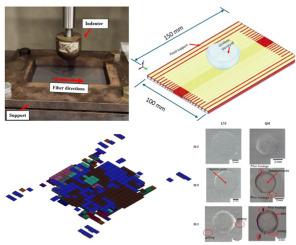Investigating the interchangeability of low-velocity impact and quasi-static indentation Tests: Effects on the residual strength of hybrid aluminum/CFRP laminates
IF 9.8
1区 材料科学
Q1 MATERIALS SCIENCE, COMPOSITES
引用次数: 0
Abstract
This study uses numerical methods, validated through laboratory experiments, to compare the mechanical behavior of hybrid aluminum/CFRP laminates under low-velocity impact (LVI) and quasi-static indentation (QSI) loading conditions. The study demonstrates that although both loading types show comparable force-displacement responses within a limited range, the divergence increases at higher LVI energy levels. Oscillations in the LVI force-displacement curve become more pronounced due to inertia and damage formation. In terms of damage, intralaminar failure in CFRP layers occurs under both loading conditions, but delamination is more pronounced under LVI loading. The study also finds that QSI produces more visible contact traces on the specimen surface compared to LVI, with smaller indenters resulting in clearer damage patterns. Simulations of tensile strength after impact reveal that LVI leads to lower residual tensile strength compared to QSI. Based on these findings, we conclude that QSI can be used as a substitute for LVI testing under certain conditions, particularly for low-impact energies (5–15 J), where delamination does not occur. However, for higher impact energies (20–30 J), significant differences in damage mechanisms indicate that the two methods should not be considered interchangeable for all applications. Further research is needed to establish clear criteria for using quasi-static tests as substitutes for low-velocity impact tests, especially for specific material configurations and conditions.

研究低速冲击和准静态压痕试验的互换性:对铝/碳纤维复合材料层合板残余强度的影响
本研究采用数值方法,通过室内实验验证,比较了低速冲击(LVI)和准静态压痕(QSI)加载条件下铝/CFRP复合材料的力学行为。研究表明,尽管两种加载类型在有限范围内表现出相似的力-位移响应,但在LVI能量水平较高时,差异增大。由于惯性和损伤的形成,LVI力-位移曲线的振荡变得更加明显。损伤方面,两种加载条件下CFRP层均发生层内破坏,但在LVI加载下分层更为明显。研究还发现,与LVI相比,QSI在试样表面产生更多可见的接触痕迹,更小的压痕导致更清晰的损伤模式。对冲击后拉伸强度的模拟表明,与QSI相比,LVI导致的残余拉伸强度更低。基于这些发现,我们得出结论,在某些条件下,QSI可以作为LVI测试的替代品,特别是在低冲击能量(5-15 J)的情况下,不会发生分层。然而,对于更高的冲击能量(20-30 J),损伤机制的显著差异表明,这两种方法不应被认为是可互换的所有应用。需要进一步研究,以确定使用准静态试验代替低速冲击试验的明确标准,特别是针对特定的材料结构和条件。
本文章由计算机程序翻译,如有差异,请以英文原文为准。
求助全文
约1分钟内获得全文
求助全文
来源期刊

Composites Science and Technology
工程技术-材料科学:复合
CiteScore
16.20
自引率
9.90%
发文量
611
审稿时长
33 days
期刊介绍:
Composites Science and Technology publishes refereed original articles on the fundamental and applied science of engineering composites. The focus of this journal is on polymeric matrix composites with reinforcements/fillers ranging from nano- to macro-scale. CSTE encourages manuscripts reporting unique, innovative contributions to the physics, chemistry, materials science and applied mechanics aspects of advanced composites.
Besides traditional fiber reinforced composites, novel composites with significant potential for engineering applications are encouraged.
 求助内容:
求助内容: 应助结果提醒方式:
应助结果提醒方式:


